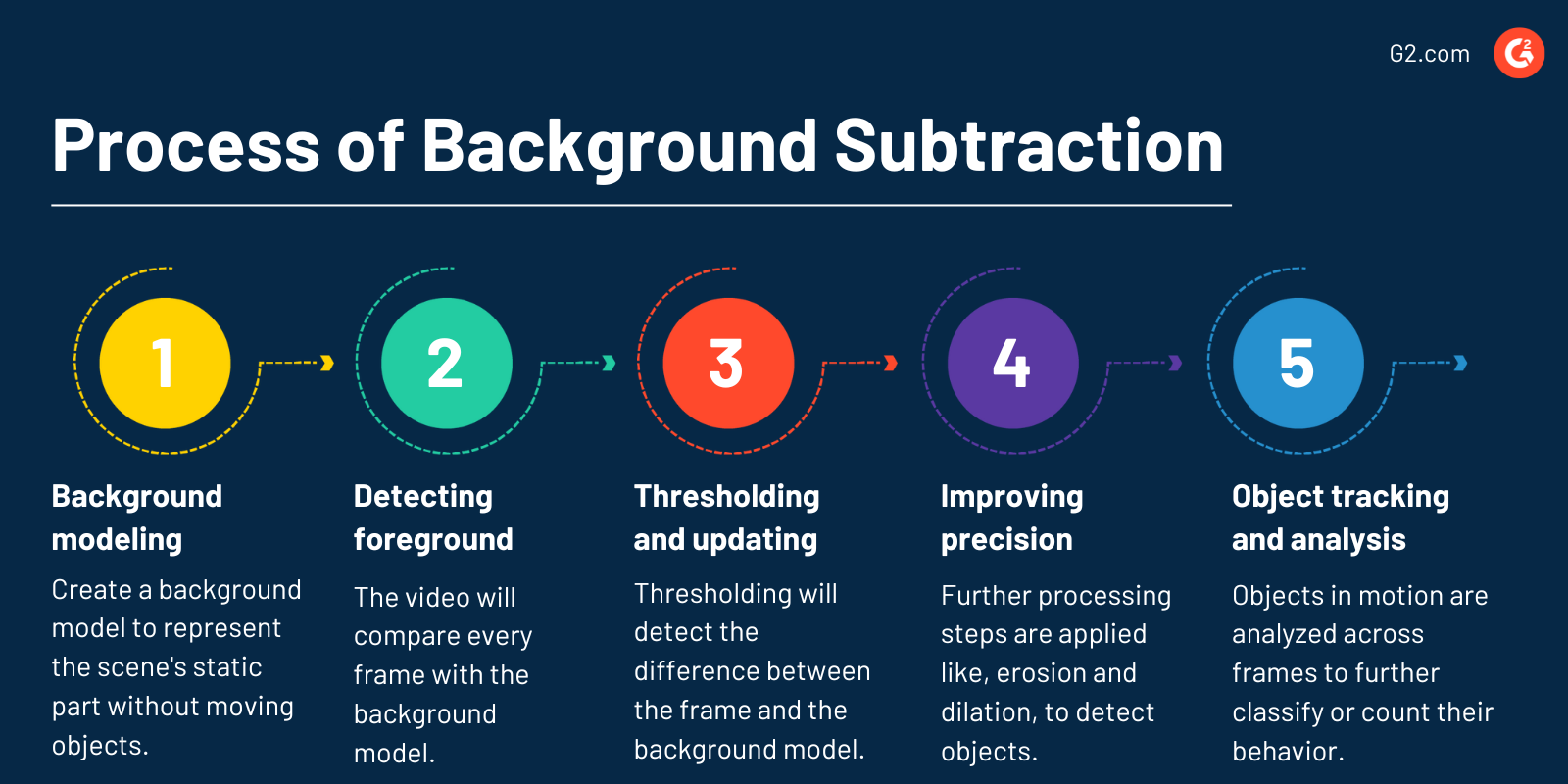What is background subtraction?
Background subtraction is a technique widely used in video processing and computer vision for detecting objects in motion. An algorithm compares moving objects in the video to a foreground and a background image.
It helps in situations that involve tracking and identifying objects like traffic monitoring and surveillance. Films and television productions also use background subtraction to create virtual sets.
Many researchers use statistical analysis software to analyze background subtraction and conduct spectrum identification research.
Applications of background subtraction
Background subtraction is a fundamental technique used in computer vision. Its uses and applications are widespread across various domains. Below are some significant applications where background subtraction plays a very crucial role.
- Video surveillance systems rely heavily on background subtraction to detect and track objects in a monitored environment. Removing the static background allows these systems to start alarms or actions when a discrepancy is detected.
- Object tracking keeps a watch on the vehicles on roads and monitors animals in sanctuaries.
- Gesture recognition helps isolate gestures or movements made by objects or individuals from the background noise. It is essential for controlling devices, virtual reality (VR) environments, and gaming with gestures.
- Augmented reality (AR) apps superimpose digital information or objects on simple pictures captured with a camera. Background subtraction differentiates between real-world scenes and virtual elements to create smooth AR experiences.
- Medical imaging isolates specific regions or structures of interest in medicine-related images. Professionals use background subtraction to enhance images and segment objects.
Process of background subtraction
Background subtraction works with a static background through the following steps:

- Background modeling: Creating a model of the background will represent the video scene's static part without moving objects. It comprises a single image, allowing a more detailed model with lighting, shadows, or highlight variations.
- Detecting foreground: The video compares every new frame with the background model. The frames or parts of the structure showing significant differences from the background will be considered the foreground.
- Thresholding and updating: Thresholding detects the difference between the current frame and the background model. It compares pixels of the background and foreground objects. Professionals can update this model according to needs and requirements to match the changes made to the scenes.
- Improving precision: Professionals apply further processing steps like noise reduction, erosion, and dilation to improve the precision of detected objects.
- Object tracking and analysis: Professionals analyze objects in motion across frames to further classify, count, or analyze their behavior.
Background subtraction techniques and algorithms
Different techniques and algorithms have been developed to address various scenarios and challenges when it comes to background subtraction. From simple methods suitable for static scenes to advanced algorithms required for dynamic environments, there is a range of techniques available.
- Static background subtraction: There are two forms of static background subtraction, basic subtraction and frame differencing. Basic subtraction, which is better suited for static scenes, involves removing a single reference frame from the current frame to detect moving objects. Frame differencing calculates the difference in pixel values between consecutive frames, detecting sudden changes as well as variations in noise and lighting conditions.
- Adaptive background subtraction: This comprises two methods, the Running Average Method and the Mixture of Gaussians. The Running Average Method is useful in situations where the background is likely to change frequently. It helps maintain an adaptive background model by updating it based on the current frame. The Gaussian Mixture Model (GMM) is an improved adaptive background subtraction method that models the pixel distribution as a mix of Gaussians. This makes it more suitable for handling complex and significant changes in lighting conditions. It is important to note that Gaussian is a mathematical function in its basic form.
- Advanced algorithms. There are multiple advanced algorithms like Convolution Neural Networks (CNN) that can enhance the process of deep learning in background subtraction. These CNN-based models are capable of learning intricate features from input frames, which makes them competent to tackle complex challenges like shadows, reflections, and dynamic backgrounds. Recurrent Neural Networks (RNNs) can capture short-term dependencies in sequences of videos. Certain types of RNNs have helped model spatial and temporal data for more accuracy. Hybrid approaches combine traditional techniques with deep learning models to leverage the best features.
Background subtraction best practices
Below are certain best practices that should be considered while implementing background subtraction effectively.
- Use clean and well-prepared data to enhance the accuracy of the outputs. Some data preprocessing steps to be considered before analyzing the data are noise reduction, color space conversion, image enhancement, and calibration.
- Tune parameters for background subtraction algorithms for optimized performance. Threshold selection, learning rate, history, and evaluation metrics are some approaches for parameter tuning.
- Choose a relevant algorithm by considering data characteristics and the algorithm’s robustness to align with data and the project’s goals.
- Make hardware considerations to ensure efficient processing for live applications such as augmented reality or video surveillance in short durations. This helps verify the best outcomes for graphical processing unit (GPU) acceleration, efficient usage of memory, parallelization, and hardware compatibility.
Learn more about statistics modeling to prepare data for efficient and practical analysis.

Sagar Joshi
Sagar Joshi is a former content marketing specialist at G2 in India. He is an engineer with a keen interest in data analytics and cybersecurity. He writes about topics related to them. You can find him reading books, learning a new language, or playing pool in his free time.

